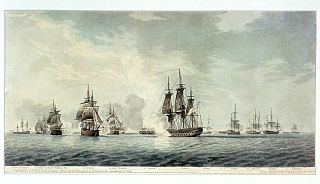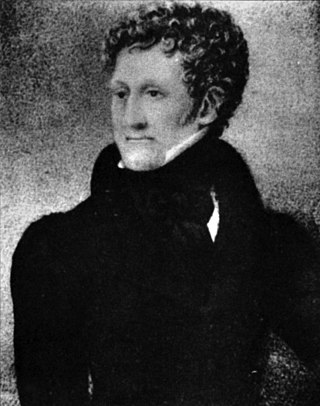
HMS Babet was a 20-gun sixth-rate post ship of the British Royal Navy. She had previously been a corvette of the French Navy under the name Babet, until her capture in 1794, during the French Revolutionary Wars. She served with the British, capturing several privateers and other vessels, and was at the Battle of Groix. She disappeared in the Caribbean in 1800, presumably having foundered.
Jean Bart may refer to one of the following ships of the French Navy or privateers named in honour of Jean Bart, a French naval commander and privateer.

Courageuse was a 40-gun Virginie-class frigate of the French Navy, completed in 1794 and renamed Justice in April 1795. The British and Ottomans captured her in 1801 at the siege of Alexandria and she became a prize to the Ottomans.
Mutine was an 18-gun Belliqueuse-class gun-brig of the French Navy, built to a design by Pierre-Alexandre-Laurent Forfait, and launched in 1794 at Honfleur. She took part in the Battle of Santa Cruz de Tenerife, where the British captured her. She was recommissioned in the Royal Navy as HMS Mutine, and eventually sold in 1803.

Pomone was a 40-gun frigate of the French Navy, launched in 1785. The British captured her off the Île de Batz in April 1794 and incorporated her into the Royal Navy. Pomone subsequently had a relatively brief but active career in the British Navy off the Atlantic and Mediterranean coasts of France before suffering sufficient damage from hitting a rock to warrant being taken out of service and then broken up in 1803.
Sardine was a corvette of the French Navy, launched in 1771. The Royal Navy captured her at the Siege of Toulon but the French retook her when the Anglo-Spanish force retreated. The Royal Navy captured her again in 1796. She then served as HMS Sardine until the Royal Navy sold her in 1806.

Charles Lydiard was an officer of the Royal Navy who served during the French Revolutionary and Napoleonic Wars.
The French brig Alerte was launched in April 1787. The Royal Navy captured her at Toulon in August 1793, and renamed her HMS Vigilante. The British set her on fire when they evacuated Toulon in December of that year. After the French rebuilt her as Alerte, she served at the Battle of Aboukir Bay. The British recaptured her in June 1799 and took her into service as HMS Minorca. Minorca was sold in 1802.

Rear-Admiral James Macnamara was an officer of the Royal Navy who served during the American War of Independence and the French Revolutionary and Napoleonic Wars.

HMS Southampton was the name ship of the 32-gun Southampton-class fifth-rate frigates of the Royal Navy. She was launched in 1757 and served for more than half a century until wrecked in 1812.
Perdrix was a corvette of the French Royal Navy, launched in 1784. The British captured her off Antigua in 1795 and she served briefly in the Royal Navy in the West Indies, where she captured a French privateer, before being broken up in 1798.
Pandour was a French a 14-gun gun-brig launched in 1780 as a cutter. The Royal Navy captured her in December 1795 and took her into service as Pandora, but she foundered in June 1797.
Flèche was a French corvette built by Louis-Hilarion Chapelle (cadet) and launched at Toulon, France in 1768. The British captured her at the Fall of Bastia in May 1794 and commissioned her into the Royal Navy under her existing name. She observed the naval Battle of Hyères Islands, but then was wrecked in 1795.
Poulette was a French Coquette-class corvette built to a design by Joseph-Marie-Blaise Coulomb and launched in March 1781. She served the French navy until 1793 when the British captured her at Toulon in 1793. She served briefly in the Royal Navy, including at the battle of Genoa in 1795, until she was burned in October 1796 to prevent her falling into French hands.
HMS Avenger was a 16-gun ship-sloop of the British Royal Navy. Previously she was the French privateer Marseillaise and then naval corvette Vengeur, which the British Army captured during the battle for Martinique in 1794. The Admiralty sold her in 1802.
Seven ships of the French Navy have borne the name Sans-Culotte in honour of the Sans-culottes:

The French corvette Naïade was launched at Brest in 1793 as a brig-corvette for the French Navy. The Royal Navy captured her in 1805 and took her into service as HMS Melville. She was sold for breaking up in 1808.
Belliquese was a French Navy 12-gun brig launched in 1793 as the name-vessel of her class, and sold in 1797 to serve as a privateer. The British Royal Navy captured her in 1798. Though the Royal Navy named her HMS Bellete and took her measurements, it never actually commissioned her; she was sold in 1801.
HMS Amethyst was launched in 1790 as the French frigate Perle. The British Royal Navy took possession of her at Toulon in 1793. She was wrecked in 1795 at Alderney.
El Corso was launched in Spain in 1791 as a naval brig. the British Royal Navy captured her in 1796 and took her into service as HMS Corso. She then served in the Mediterranean where she captured numerous small vessels, the great majority of which were merchant vessels. In 1802 she sailed to England. From July 1802 to her sale in September 1814 she served as a receiving ship.






